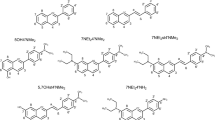Abstract
Endogenous chromophores in human skin, when exposed to sunlight, generate harmful reactive oxygen species (ROS). Protoporphyrin IX (PpIX) is one of the common chromophores in human tissue. A series of aromatic cyanoacrylates were tested as quenchers of excited singlet and triplet states of PpIX. While the diaryl cyanoacrylate (1) did not quench excited singlet or triplet states of PpIX, some cyanoacrylates with fused aromatic rings showed excited singlet state quenching rate constants as high as 5 × 109 M−1 s−1 (acetonitrile solution). In addition, one of the fused ring cyanoacrylates (5) quenches PpIX triplet states with a rate constant of 3 × 109 M−1 s−1. The observed quenching rate constants correlated well with the suppression of singlet oxygen generation from PpIX under visible light exposure in the presence of dissolved oxygen. This photostabilization of endogenous chromophores can prevent or reduce ROS generation and perhaps constitute a new approach to mitigating cutaneous oxidative stress.
Similar content being viewed by others
References
G. T. Wondrak, M. K. Jacobson, E. L. Jacobson, Endogenous UVA-photosensitizers: mediators of skin photodamage and novel targets for skin photoprotection, Photochem. Photobiol. Sci., 2006, 5, 215–237.
C. Lentner, Geigy Scientific Tables, Ciba-Geigy Limited, Basle, Switzerland, 1984.
C. Pourzand, O. Reelfs, E. Kvam, R. M. Tyrrell, The iron regulatory protein can determine the effectiveness of 5-aminolevulinic acid in inducing protoporphyrin IX in human primary skin fibroblasts, J. Invest. Dermatol., 1999, 112, 419–425.
G. I. Lozovaya, Z. Masinovsky, A. A. Sivash, Protoporphyrin IX as a possible ancient photosensitizer: spectral and photophysical studies, Origins Life Evol. Biospheres, 1990, 20, 321–330.
M. Gouterman, G.-E. Khalil, Porphyrin free base phosphorescence, J. Mol. Spectrosc., 1974, 53, 88–100.
E. Balasubramaniam, P. Natarajan, Photophysical properties of protoporphyrin IX and thionine covalently attached to macromolecules, J. Photochem. Photobiol., A, 1997, 103, 201–211.
C. B. Nielsen, J. S. Forster, P. R. Ogilby, S. B. Nielsen, Delayed dissociation of photoexcited porphyrin cations in a storage ring: Determination of triplet quantum yields, J. Phys. Chem. A, 2005, 109, 3875–3879.
A. A. Krasnovsky, Photoluminescence of singlet oxygen in pigment solutions, Photochem. Photobiol., 1979, 29, 29–36.
J. M. Fernandez, M. D. Bilgin, L. I. Grossweiner, Singlet oxygen generation by photodynamic agents, J. Photochem. Photobiol., B, 1997, 37, 131–140.
L. F. Agnez-Lima, J. T. A. Melo, A. E. Silva, A. H. S. Oliveira, A. R. S. Timoteo, K. M. Lima-Bessa, G. R. Martinez, M. H. G. Medeiros, P. Di Mascio, R. S. Galhardo, C. F. M. Menck, DNA damage by singlet oxygen and cellular protective mechanisms, Mutat. Res., 2012, 751, 15–28.
Y. Hiraku, K. Ito, K. Hirakawa, S. Kawanishi, Photosensitized DNA Damage and its Protection via a Novel Mechanism, Photochem. Photobiol., 2007, 83, 205–212.
J. Cadet, T. Douki, J.-L. Ravanat, P. Di Mascio, Sensitized formation of oxidatively generated damage to cellular DNA by UVA radiation, Photochem. Photobiol. Sci., 2009, 8, 903–911.
S. Pillai, C. Oresajo, J. Hayward, Ultraviolet radiation and skin aging: roles of reactive oxygen species, inflammation and protease activation, and strategies for prevention of inflammation-induced matrix degradation–a review, Int. J. Cosmet. Sci., 2005, 27, 17–34.
D. R. Bickers, M. Athar, Oxidative Stress in the Pathogenesis of Skin Disease, J. Invest. Dermatol., 2006, 126, 2565–2575.
M. A. Farage, K. W. Miller, P. Elsner, H. I. Maibach, Intrinsic and extrinsic factors in skin ageing: a review, Int. J. Cosmet. Sci., 2008, 30, 87–95.
R. S. Sinclair, D. Tait, T. G. Truscott, Triplet states of protoporphyrin IX and protoporphyrin IX dimethyl ester, J. Chem. Soc., Faraday Trans. 1, 1980, 76, 417–425.
A. U. Khan, M. Kasha, Direct spectroscopic observation of singlet oxygen emission at 1268 nm excited by sensitized dyes of biological interest in liquid solution, Proc. Natl. Acad. Sci. U. S. A., 1979, 76, 6047–6049.
C. Schweitzer, R. Schmidt, Physical Mechanisms of Generation and Deactivation of Singlet Oxygen, Chem. Rev., 2003, 103, 1685–1757.
M. Montalti, A. Credi, L. Prodi and M. T. Gandolfi, Handbook of Photochemistry, CRC Press LLC, Boca Raton, 3rd edn, 2006.
Y. Yagci, S. Jockusch, N. J. Turro, Mechanism of Photoinduced Step Polymerization of Thiophene by Onium Salts: Reactions of Phenyliodinium and Diphenylsulfinium Radical Cations with Thiophene, Macromolecules, 2007, 40, 4481–4485.
Author information
Authors and Affiliations
Corresponding author
Additional information
Electronic supplementary information (ESI) available: Determination of the quenching rate constants of PpIX singlet and triplet excited states by molecular oxygen; determination of 1O2 quenching rate constants by 1 and 2. See DOI: 10.1039/c4pp00090k
Rights and permissions
About this article
Cite this article
Jockusch, S., Bonda, C. & Hu, S. Photostabilization of endogenous porphyrins: excited state quenching by fused ring cyanoacrylates. Photochem Photobiol Sci 13, 1180–1184 (2014). https://doi.org/10.1039/c4pp00090k
Received:
Accepted:
Published:
Issue Date:
DOI: https://doi.org/10.1039/c4pp00090k




